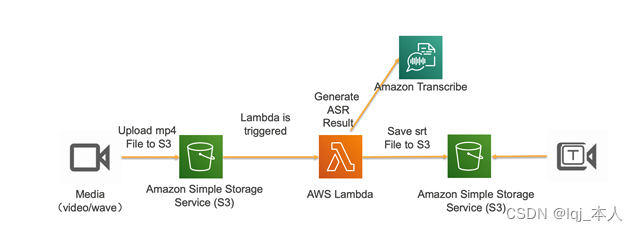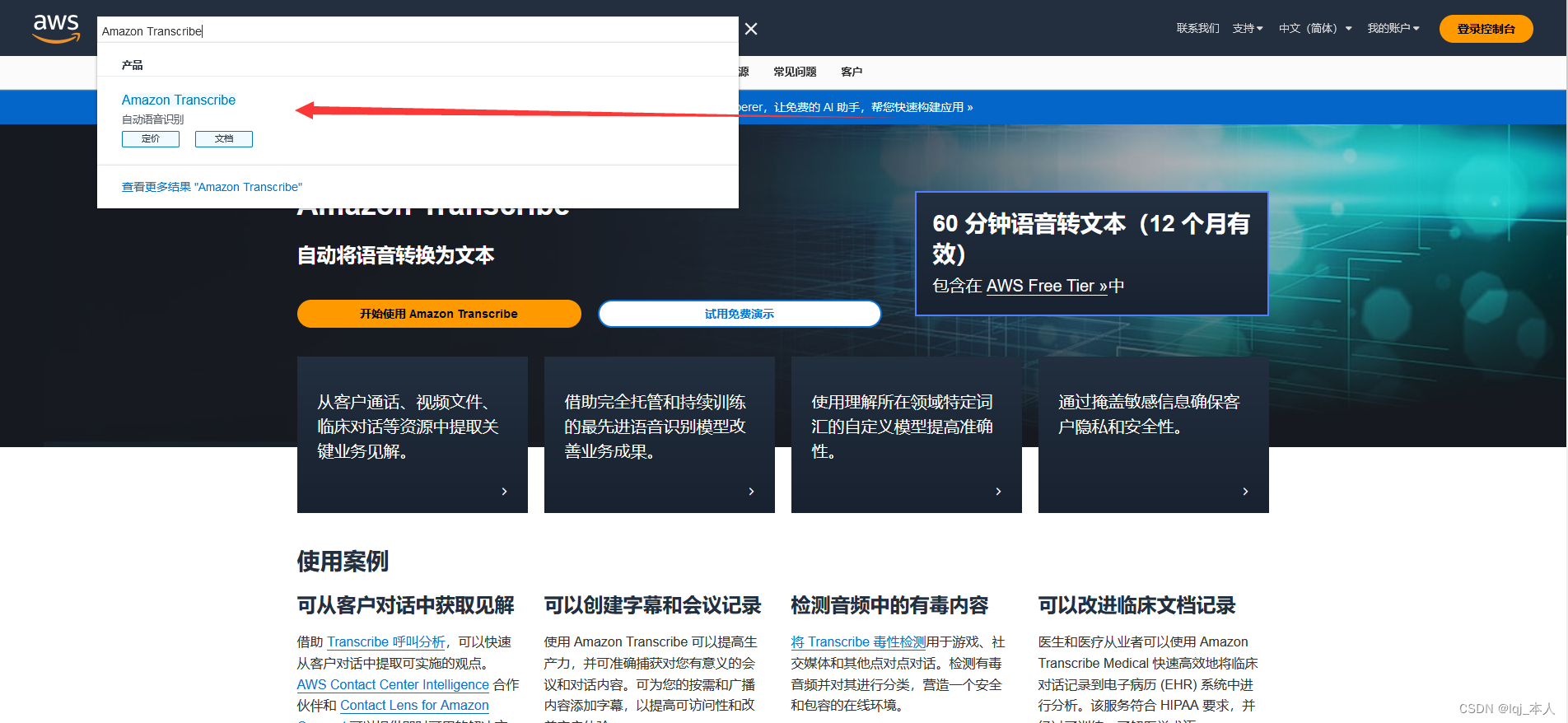亚马逊云 AI 大语言模型应用下的创新 Amazon Transcribe 的使用
- 2023-11-14 山东
本文字数:9533 字
阅读完需:约 31 分钟
Transcribe 简介
语音识别技术,也被称为自动语音识别(Automatic Speech Recognition,简称 ASR),其目标是将人类的语音中的词汇内容转换为计算机可读的输入,例如按键、二进制编码或者字符序列。语音识别技术已经发展了几十年,直到 2009 年,Hinton 把人工智能深度学习解决方案引入语音识别中,语音识别才取得了巨大突破。
Amazon Transcribe 是一项自动语音识别 (ASR) 服务,使开发人员能够轻松地为其应用程序添加语音转文本功能。自从在 re:Invent 2017 发布以来,越来越多的用户将语音识别功能添加到其应用程序和设备中。2019 年 8 月,Amazon Transcribe 推出对中文普通话的支持。更加另用户兴奋的是,在中国的北京区域(BJS)和宁夏区域(ZHY)也已支持该项服务。
在日常工作学习中,我们往往需要对一个视频文件增加字幕。传统的方法需要将视频中的对话用文字记录下来,通常采用记事本等工具保存文字记录,然后借助一些工具软件为文字加上时间轴,然后进行人工校对,整个过程需要耗费大量的时间和精力。是否有更快捷的方法呢?下面我们分享一个使用 Amazon Transcribe 为视频自动增加字幕的示例。
AWS Transcribe 服务于利用机器学习来识别语音文件中的声音,然后将其转化为文本。目前支持英语和西班牙文语音。必须将语音文件保存在 S3 中,输出结果也会被保存在 S3 中。
输入声音文件,支持 flac、mp3、mp4 和 wav 文件格式。长度不能超过 2 小时。
指定语言。
几个特色功能:
发音者识别(speaker identification):Transcribe 能区别一个语音文件中的多个说话者。支持 2 到 10 个发音者
支持多声道(channel identification): 如果声音文件中有多声道
支持字典(vocabulary):比如不能识别的单词,特定领域不常用的单词
体系架构

监测到 S3 存储桶中的文件变化,触发 lambda 函数;
lambda 函数调用 Transcribe 服务,生成视频对应的文本(json 格式);
对文本进行格式转换,生成字幕文件格式(srt);
上传字幕文件到存储桶。
控制台操作展示
登录自己的 AWS 账号进入到 aws 控制管理台, 然后搜索 Transcribe 进入到这个管理后台


点击 Create job 按钮就可以使用 AWS 的语音转文本服务,根据提示添加必备的参数设置

api 接口
StartTranscriptionJob:开始一个转换任务
ListTranscriptionJobs:获取任务列表
GetTranscriptionJob:获取任务
CreateVocabulary:创建字典
DeleteVocabulary:删除字典
GetVocabulary:获取字典
ListVocabularies:获取字典列表
UpdateVocabulary:上传字典
python 使用 Transcribe 演示实例
类型 1
import timeimport boto3
transcribe = boto3.client(('transcribe'))job_name = "testTranscribeJob100"job_uri = "https://s3.dualstack.us-east-1.amazonaws.com/*****/hellosammy.mp3"
transcribe.start_transcription_job(TranscriptionJobName=job_name, Media={'MediaFileUri': job_uri}, MediaFormat='mp3', LanguageCode='en-US')
while True: status = transcribe.get_transcription_job(TranscriptionJobName = job_name) if status['TranscriptionJob']['TranscriptionJobStatus'] in ['COMPLETED', "FAILED"]: break
print("Job not ready yet...") time.sleep(5)
print(status)
类型 2
安装 Python 的程序包
pip3 install boto3pip3 install amazon_transcribepip3 install websocket-client
import 部分
import hashlibimport hmacimport urllib.parsefrom datetime import datetimeimport timeimport sslimport jsonimport websocketimport _threadfrom amazon_transcribe.eventstream import EventStreamMessageSerializerfrom amazon_transcribe.eventstream import EventStreamBufferfrom boto3.session import Session
创建 URL 函数
def sign(key, msg): return hmac.new(key, msg.encode("utf-8"), hashlib.sha256).digest() def getSignatureKey(key, dateStamp, region, serviceName): kDate = sign(("AWS4" + key).encode("utf-8"), dateStamp) kRegion = sign(kDate, region) kService = sign(kRegion, serviceName) kSigning = sign(kService, "aws4_request") return kSigning def create_pre_signed_url(region, language_code, media_encoding, sample_rate): # 获得access key和secret key credentials = Session().get_credentials() access_key_id = credentials.access_key secret_access_key = credentials.secret_key method = "GET" service = "transcribe" endpoint = "wss://transcribestreaming." + region + ".amazonaws.com:8443" host = "transcribestreaming." + region + ".amazonaws.com:8443" algorithm = "AWS4-HMAC-SHA256" t = datetime.utcnow() amz_date =t.strftime('%Y%m%dT%H%M%SZ') datestamp =t.strftime('%Y%m%d') canonical_uri = "/stream-transcription-websocket" canonical_headers = "host:" + host + "\n" signed_headers = "host" credential_scope = datestamp + "/" + region + "/" + service + "/" + "aws4_request" canonical_querystring = "X-Amz-Algorithm=" + algorithm canonical_querystring += "&X-Amz-Credential=" + urllib.parse.quote_plus(access_key_id + "/" + credential_scope) canonical_querystring += "&X-Amz-Date=" + amz_date canonical_querystring += "&X-Amz-Expires=300" canonical_querystring += "&X-Amz-SignedHeaders=" + signed_headers canonical_querystring += "&language-code="+ language_code +"&media-encoding=" + media_encoding +"&sample-rate=" + sample_rate # Zero length string for connecting payload_hash = hashlib.sha256(("").encode('utf-8')).hexdigest() canonical_request = method + '\n' \ + canonical_uri + '\n' \ + canonical_querystring + '\n' \ + canonical_headers + '\n' \ + signed_headers + '\n' \ + payload_hash string_to_sign = algorithm + "\n" \ + amz_date + "\n" \ + credential_scope + "\n" \ + hashlib.sha256(canonical_request.encode("utf-8")).hexdigest() signing_key = getSignatureKey(secret_access_key, datestamp, region, service) signature = hmac.new(signing_key, string_to_sign.encode("utf-8"), hashlib.sha256).hexdigest() canonical_querystring += "&X-Amz-Signature=" + signature request_url = endpoint + canonical_uri + "?" + canonical_querystring return request_url
main 函数
def main(): url = create_pre_signed_url("us-east-1", "en-US", "pcm", "16000") ws = websocket.create_connection(url, sslopt={"cert_reqs": ssl.CERT_NONE}) _thread.start_new_thread(loop_receiving, (ws,)) print("Receiving...") send_data(ws) while True: time.sleep(1)main()
loop_receiving 函数
该函数位于 main 函数上方。它将接收 Amazon Transcribe Streaming Service 的返回数据,并且打印出来。
def loop_receiving(ws): try: while True: result = ws.recv() if result == '': continue eventStreamBuffer = EventStreamBuffer() eventStreamBuffer.add_data(result) eventStreamMessage = eventStreamBuffer.next() stream_payload = eventStreamMessage.payload transcript = json.loads(bytes.decode(stream_payload, "UTF-8")) print("response:",transcript) results = transcript['Transcript']['Results'] if len(results)>0: for length in range(len(results)): if 'IsPartial' in results[length]: print('IsPartial:', results[length]['IsPartial']) if 'Alternatives' in results[length]: alternatives = results[length]['Alternatives'] if len(alternatives)>0: for sublength in range(len(alternatives)): if 'Transcript' in alternatives[sublength]: print('Transcript:', alternatives[sublength]['Transcript']) except Exception as e: if 'WebSocketConnectionClosedException' == e.__class__.__name__: print("Error: websocket connection is closed") else: print(f"Exception Name: {e.__class__.__name__}")
send_data 函数
该函数位于 main 函数上方。它将发送音频数据到 Amazon Transcribe Streaming Service。其中 testFile 变量是测试音频文件地址,测试音频为 pem 格式,英语,采样率为 16000。
def send_data(ws): testFile = "xxx.pem" bufferSize = 1024*16 stream_headers = { ":message-type": "event", ":event-type": "AudioEvent", ":content-type": "application/octet-stream", } eventstream_serializer = EventStreamMessageSerializer() with open(testFile, "rb") as source: while True: audio_chunk = source.read(bufferSize) # 将音频数据进行编码 event_bytes = eventstream_serializer.serialize(stream_headers, audio_chunk) ws.send(event_bytes, opcode = 0x2) # 0 x 2 send binary # end with b'' data bytes if len(audio_chunk) == 0: break
java 使用 Transcribe 演示实例
import com.amazonaws.AmazonServiceException;import com.amazonaws.SdkClientException;import com.amazonaws.auth.AWSCredentials;import com.amazonaws.auth.AWSStaticCredentialsProvider;import com.amazonaws.auth.BasicAWSCredentials;import com.amazonaws.auth.profile.ProfileCredentialsProvider;import com.amazonaws.regions.Regions;import com.amazonaws.services.s3.AmazonS3;import com.amazonaws.services.s3.AmazonS3Client;import com.amazonaws.services.s3.AmazonS3ClientBuilder;import com.amazonaws.services.s3.model.*;import com.amazonaws.services.s3.transfer.TransferManager;import com.amazonaws.services.s3.transfer.Upload;import com.amazonaws.services.transcribe.AmazonTranscribe;import com.amazonaws.services.transcribe.AmazonTranscribeClientBuilder;import com.amazonaws.services.transcribe.model.*;import org.omg.CosNaming.NamingContextExtPackage.StringNameHelper; import java.io.*;import java.util.ArrayList;import java.util.Arrays;import java.util.List; /** * 代码注意: 生成job只保存到S3,所以要保存到本地的思路是先保存到S3,然后下载, * 但是期间需要时间,所以不断的查询是否存在在不断的遍历循环比较慢 * * @author DELL * @Desc 将本地MP3上传到S3, 然后再转文本,保存json 文件到本地 * 基本步骤: * 1.建立S3客户端连接 * 2.上传本地音频到S3库中,并返回一个S3地址 * 3.上传MP3对应的备用单词词库 * 3.在Amazon Transcribe 创建一个job,将生成的json 文件保存到MP3同级目录 */public class Mp3ToJsonUtils { // 执行文件配置信息 private static String FILE_TYPE = "mp3"; // S3配置信息 private static String AWS_ACCESS_KEY = "自己生成"; private static String AWS_SECRET_KEY = "自己生成"; private static final String BUCKET_NAME = "自己生成"; private static final String JOB_BUCKET_NAME = "自己生成"; // Aws对象信息 private static AmazonS3 s3; private static TransferManager tx; private static AmazonTranscribe amazonTranscribe; private static BasicAWSCredentials awsCredentials; static { //1. 建立连接 try { init_with_key(); } catch (Exception e) { e.printStackTrace(); } awsCredentials = new BasicAWSCredentials(AWS_ACCESS_KEY, AWS_SECRET_KEY); amazonTranscribe = AmazonTranscribeClientBuilder.standard().withCredentials(new AWSStaticCredentialsProvider(awsCredentials)).withRegion(Regions.US_EAST_2).build(); } public static void main(String[] args) throws Exception { List<String> list = new ArrayList<>(); mp3TOJosn("C:\\Users\\DELL\\Desktop\\BK测试数据\\A_Cinderella_Atlas_5.mp3", list); } public static void mp32Josn(String inPath, String savePath, List<String> list) throws Exception { String jsonPath = new File(inPath).getParent(); String name = new File(inPath).getName().replaceAll(" ", "_").replaceAll("-", "_"); File file = new File(savePath + "\\" + name + ".json"); //确保上传一次 if (file.exists()) { System.out.println(savePath + "--->已经处理完毕,跳过处理"); return; } //2. 上传文件到S3库,得到上传文件对应的S3 URL String s3Path = uploadFileToBucket(inPath, BUCKET_NAME); String key = new File(s3Path).getName(); key = key.replaceAll(" ", "_").replaceAll("-", "_"); //3. 创建Transcription jobs createJob(JOB_BUCKET_NAME, FILE_TYPE, key, s3Path); //4. 将json文件下载到本地和MP3 同目录 // 在创建job 生成json 的时候需要一定的时间,先等待一段时间,然后判断存在不存在 boolean flag = isObjectExit(BUCKET_NAME, key + ".json"); while (!flag) { flag = isObjectExit(BUCKET_NAME, key + ".json"); } amazonS3Downloading(s3, JOB_BUCKET_NAME, key + ".json", savePath + "\\" + key + ".json"); } /** * 将 MP3 转成 Json文件保存到本地 * * @param inPath * @throws Exception */ public static void mp3TOJosn(String inPath, List<String> list) throws Exception { String jsonPath = new File(inPath).getParentFile().getParentFile().getParentFile().getAbsolutePath() + "\\json"; File file1 = new File(jsonPath); if (!file1.exists()) { file1.mkdirs(); } mp32Josn(inPath, jsonPath, list); } /** * 通过在代码中包含 access key id 和 secret access key 连接 aws * * @throws Exception */ private static void init_with_key() throws Exception { AWSCredentials credentials = null; credentials = new BasicAWSCredentials(AWS_ACCESS_KEY, AWS_SECRET_KEY); s3 = new AmazonS3Client(credentials); //Region usWest2 = Region.getRegion(Regions.US_WEST_2); //s3.setRegion(usWest2); tx = new TransferManager(s3); } /** * 上传一个本地文件(对应位置为path)上传到名为bucketName的bucket * * @param path 需要上传文件的路径 * @param bucketName S3中存储文件的桶名称 * return 返回对应上传文件的key */ private static String uploadFileToBucket(String path, String bucketName) { String keyName = new File(path).getName(); File fileToUpload = new File(path); if (fileToUpload.exists() == false) { System.out.println(path + " not exists!"); return null; } PutObjectRequest request = new PutObjectRequest(bucketName, fileToUpload.getName(), fileToUpload); Upload upload = tx.upload(request); while ((int) upload.getProgress().getPercentTransferred() < 100) { try { Thread.sleep(1000); } catch (InterruptedException e) { // TODO Auto-generated catch block e.printStackTrace(); } } System.out.println(path + " MP3上传成功!"); String s3Path = "s3://" + BUCKET_NAME + "/" + keyName; return s3Path; } /** * 创建一个 Transcription jobs * * @param bucketName S3桶的名称 * @param fileName 文件类型 eg: mp3, mp4 * @param jobName 要创建的job的名称 * @param S3Path 对应S3桶中的对应MP3 或其他路径的S3URL * @param vocabularyName Custom vocabulary 对应的名称 */ protected static void createJob(String bucketName, String fileName, String jobName, String S3Path) { StartTranscriptionJobRequest startTranscriptionJobRequest = new StartTranscriptionJobRequest(); Media media = new Media(); media.setMediaFileUri(S3Path); // 设置JOb的相应参数 sampling rate 采(抽)样率; startTranscriptionJobRequest.withMedia(media) .withLanguageCode(LanguageCode.EnUS) .withMediaFormat(fileName) .withOutputBucketName(bucketName) .withSettings(settings) .setTranscriptionJobName(jobName); amazonTranscribe.startTranscriptionJob(startTranscriptionJobRequest); GetTranscriptionJobRequest request; request = new GetTranscriptionJobRequest(); request.withTranscriptionJobName(jobName); GetTranscriptionJobResult result = amazonTranscribe.getTranscriptionJob(request); String status = result.getTranscriptionJob().getTranscriptionJobStatus(); while (!status.toUpperCase().equals("COMPLETED")) { try { Thread.sleep(2000); } catch (InterruptedException e) { e.printStackTrace(); } //System.out.println(status); result = amazonTranscribe.getTranscriptionJob(request); status = result.getTranscriptionJob().getTranscriptionJobStatus(); if (status.toUpperCase().equals("FAILED")) { System.out.println(result.getTranscriptionJob().getTranscriptionJobName() + "---> is failed"); System.out.println(result.getTranscriptionJob().getTranscriptionJobName() + "--->" + result.getTranscriptionJob().getFailureReason()); throw new RuntimeException("transcriobe 失败"); } } System.out.println(jobName + "Mp3 Job 生成成功"); } /** * 将S3上的文件下载到本地 * * @param s3Client s3客户端 * @param bucketName 桶名称 * @param key 文件名称 * @param targetFilePath 本地路径 */ public static void amazonS3Downloading(AmazonS3 s3Client, String bucketName, String key, String targetFilePath) { S3Object object = s3Client.getObject(new GetObjectRequest(bucketName, key)); if (object != null) { System.out.println("Content-Type: " + object.getObjectMetadata().getContentType()); InputStream input = null; FileOutputStream fileOutputStream = null; byte[] data = null; try { //获取文件流 input = object.getObjectContent(); data = new byte[input.available()]; int len = 0; fileOutputStream = new FileOutputStream(targetFilePath); while ((len = input.read(data)) != -1) { fileOutputStream.write(data, 0, len); } System.out.println(targetFilePath + "json 文件下载文件成功"); } catch (IOException e) { e.printStackTrace(); } finally { if (fileOutputStream != null) { try { fileOutputStream.close(); } catch (IOException e) { e.printStackTrace(); } } if (input != null) { try { input.close(); } catch (IOException e) { e.printStackTrace(); } } } } } /** * 判断名为bucketName的bucket里面是否有一个名为key的object * * @param bucketName * @param key * @return */ private static boolean isObjectExit(String bucketName, String key) { int len = key.length(); ObjectListing objectListing = s3.listObjects(bucketName); String s = new String(); for (S3ObjectSummary objectSummary : objectListing.getObjectSummaries()) { s = objectSummary.getKey(); int slen = s.length(); if (len == slen) { int i; for (i = 0; i < len; i++) { if (s.charAt(i) != key.charAt(i)) { break; } } if (i == len) { return true; } } } return false; }}
效果演示

版权声明: 本文为 InfoQ 作者【淼.】的原创文章。
原文链接:【http://xie.infoq.cn/article/25d0f0d605dead234b7f57ced】。文章转载请联系作者。
淼.
还未添加个人签名 2022-10-24 加入
还未添加个人简介











评论